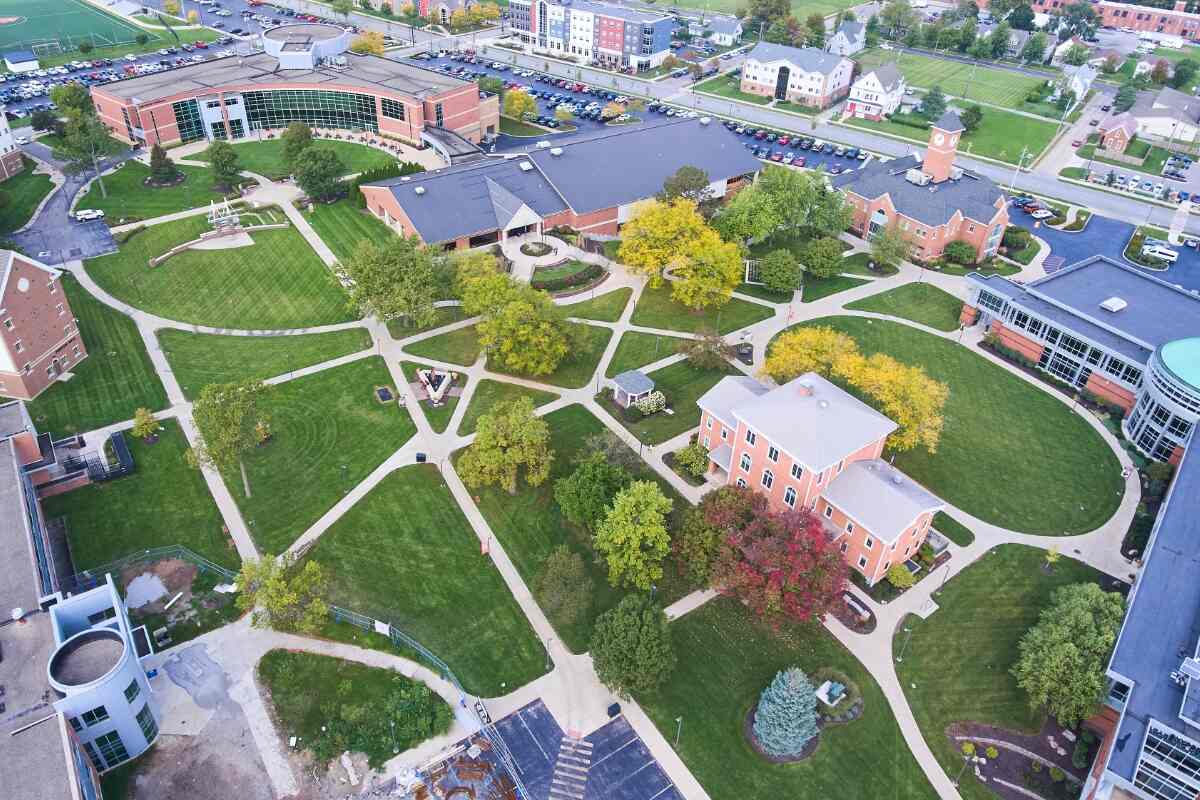
Cool-season grass types, such as Kentucky bluegrass, tall fescue, fine fescue, and perennial ryegrass, are the best grass seeds for Indiana lawns. Only cool-season grasses can survive through Indiana’s typical winter lows of around 20 to 30 degrees.
Still, some homeowners in southern regions of the state might be able to grow warm-season grasses like Zoysia. These grasses begin growing early in the spring, so your lawn turns green faster, but the tradeoff is that they go dormant and start to turn brown earlier in fall.
In this article, we’ll explore the best grass seed options for Indiana and provide tips on how to make an informed decision for your lawn’s specific needs.
Best Indiana Grass Seeds
The best types of grass seed for most Indiana lawns are cool-season grasses, including the following.
1. Fine Fescue
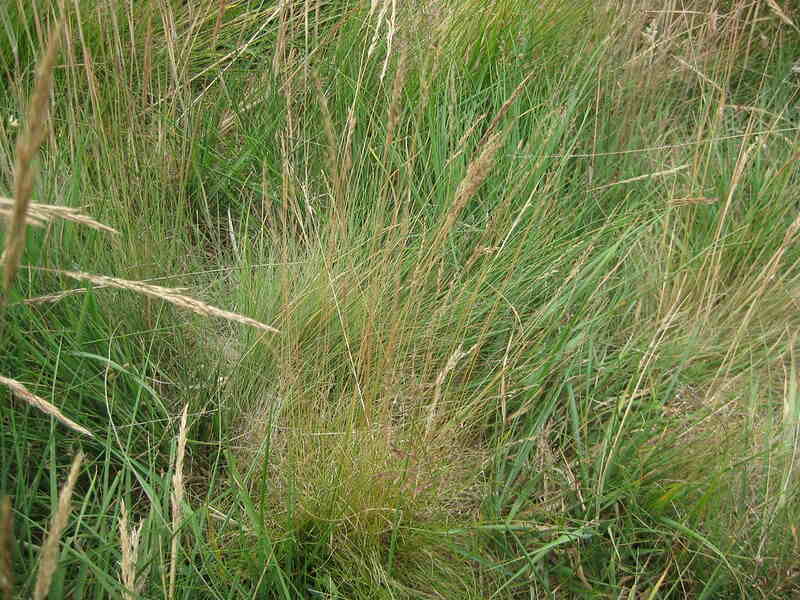
If you’re looking for grass that’s as adaptable as a chameleon, fine fescue could be your hero. It’s a great choice for Indiana lawns because of its flexibility, especially in shadier areas where other grasses would struggle. Species of fine fescue include creeping red, Chewings, sheep fescue, and hard fescue, all of which thrive in cooler months and endure Indiana’s summer heat.
Fine fescue is also a low-maintenance champion that needs less mowing and watering than many other grass types, allowing you to enjoy your lawn more with less fuss. It grows well on Indiana’s bare soil and has a strong and deep root system. So, if your Indiana lawn could use some shade-loving, low-maintenance greenery, fine fescue is a solid option.
Fine fescue at a glance:
- Classification: Cool-season grass
- Spreads by: Creeping red fescue spreads by rhizomes, while other fine fescues are bunch-type grasses.
- Shade tolerance: Moderate to high
- Drought tolerance: Moderate to high
- Foot traffic tolerance: Low to moderate
- Maintenance needs: Low fertilizer and mowing needs
- Mowing height: Set mowing height between 2.5 and 4 inches
- Potential for disease: Moderate. Common diseases include red thread, leaf spot, dollar spot, summer patch, and powdery mildew.
- Soil pH: 6-6.5
- Soil type: Will not perform well in wet soil conditions. Prefers drier soils and tolerates a wide range of soil types and fertility.
Grass Seed Options:
– Outsidepride Legacy Fine Fescue Grass Seed (5 lbs.)
– Eretz Creeping Red Fine Fescue Seed (choose your size)
– Outsidepride Creeping Red Fine Fescue Grass Seed (25 lbs.)
– Outsidepride Hard Fine Fescue Grass Seed (10 lbs.)
2. Kentucky Bluegrass
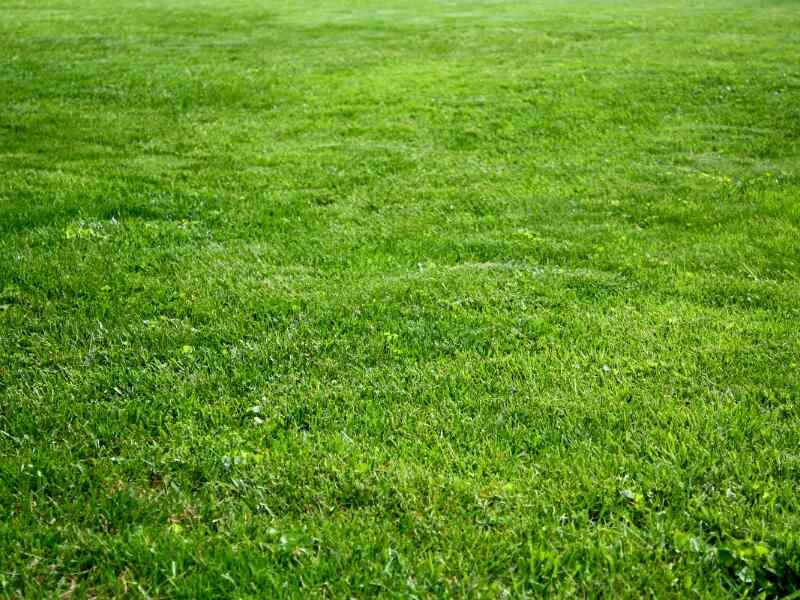
Kentucky bluegrass is perhaps the prettiest choice for Indiana lawns because it has a rich, velvety appearance that transforms your lawn into a picture-perfect oasis while also standing up to Indiana’s scorching summers and freezing winters.
This grass is tough and can withstand foot traffic and occasional roughhousing, and it’s able to fill in bare spots on its own without overseeding, keeping your lawn looking perfect. Whether your soil is sandy, loamy, or more clay-like, Kentucky bluegrass can adapt. It can also adapt to partial shade conditions, although it grows best in full sun.
Kentucky bluegrass at a glance:
- Classification: Cool-season grass
- Spreads by: Rhizomes
- Shade tolerance: Low
- Drought tolerance: Moderate
- Foot traffic tolerance: Moderate
- Maintenance needs: Moderate mowing frequency and high fertilization needs.
- Mowing height: Set mowing height between 2.5 and 3.5 inches.
- Potential for disease: Moderate to high; prone to several diseases, such as dollar spot, leaf spot, necrotic ring spot, summer patch, and stripe smut.
- Soil pH: 6-7.5
- Soil type: Performs best in well-drained, heavy soils with high fertility.
Grass Seed Options:
– Jonathan Green (11970) Blue Panther Kentucky Bluegrass Grass Seed (3 lbs.)
– SeedRanch Midnight Kentucky Bluegrass Seed (5 lbs.)
– Jacklin Seed – Biltmore Blue Blend – 100% Kentucky Bluegrass (5 lbs.)
3. Perennial Ryegrass
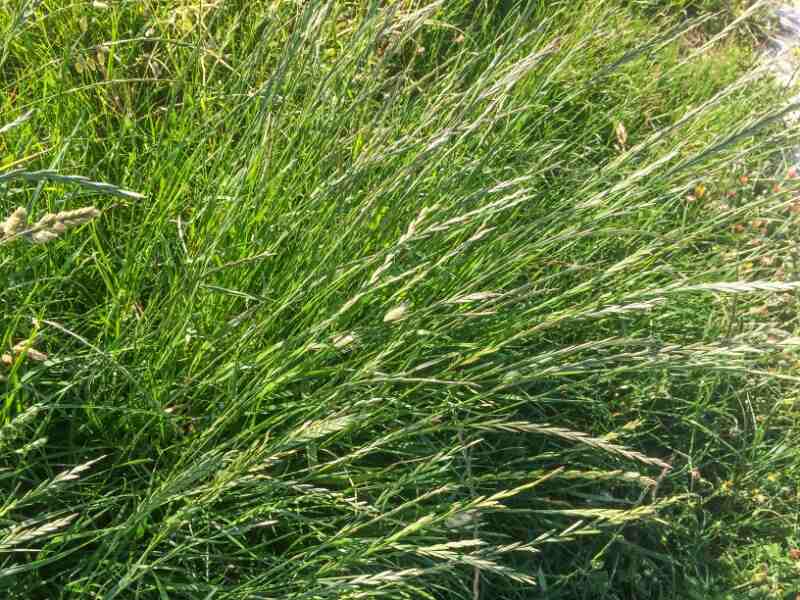
For several compelling reasons, perennial ryegrass is a fantastic choice for an Indiana lawn. For instance, it has quick germination and establishment, so you’ll have a beautiful green lawn shortly after seeding. It is especially useful in Indiana’s constantly shifting climate, where you want your grass to recover rapidly after harsh weather.
Perennial ryegrass is also noted for its excellent wear tolerance, which makes it perfect for heavy-traffic areas such as a family backyard.
Perennial ryegrass is well-known for its capacity to produce dense, aesthetically pleasing turf. Perennial ryegrass turf is distinguished by its fine texture and brilliant green color, making it an excellent choice for outdoor activities and relaxation.
Perennial ryegrass at a glance:
- Classification: Cool-season grass
- Spreads by: Has a bunch-type growth habit
- Shade tolerance: Low
- Drought tolerance: Low
- Foot traffic tolerance: High
- Maintenance needs: Moderate mowing and fertilization requirements. Thatch is not significant.
- Mowing height: Set mowing height to 1.5 to 2.5 inches
- Potential for disease: High. Common diseases include gray leaf spot, red thread, and leaf spot/melting-out.
- Soil pH: Can grow in soils with a pH between 5 and 8 but prefers between 6 and 7.
- Soil type: Prefers good drainage and fertility but can tolerate poor drainage.
Grass Seed Options:
– Outsidepride Perennial Ryegrass Seed (5 lbs.)
– Eretz ProTurf Perennial Ryegrass Fine Lawn Seed (choose your size)
4. Tall Fescue

Tall fescue is an excellent choice for an Indiana lawn due to its extraordinary adaptability, durability, and resilience. Tall fescue thrives in the diverse weather patterns of Indiana. Its deep root system allows it to survive and quickly recover from drought spells and harsh temperatures.
Its deep-rooted nature even allows tall fescue to stay green when there isn’t any rain. Furthermore, the sturdy and gritty texture of tall fescue gives a particular character to your lawn, giving it a rich and rugged appearance that can complement various landscape types.
Tall fescue at a glance:
- Classification: Cool-season grass
- Spreads by: Produces short rhizomes but has a bunch-type growth habit
- Shade tolerance: Moderate
- Drought tolerance: Moderate to high
- Foot traffic tolerance: Moderate
- Maintenance needs: Frequent mowing. Does not produce significant thatch.
- Mowing height: Set mowing height to 2 inches when grass reaches 3 inches tall.
- Potential for disease: Tolerant of most diseases when properly maintained.
- Soil pH: 5.5-6.5
- Soil type: Adapted to a wide range of soil conditions but prefers fertile clay soils with good drainage.
Grass Seed Options:
– Triple-Play Tall Fescue Grass Seed Blend (5000 sq ft)
– Eretz Kentucky 31 K31 Tall Fescue Grass Seed (choose your size)
– Pennington The Rebels Tall Fescue Grass Seed Mix (7 lb.)
Best Grass Seed for Northern Indiana
In Northern Indiana, the average temperature ranges between 15 and 30 degrees in winter and 60 and 84 degrees in summer. So, cool-season grasses like Kentucky bluegrass, fine fescue, and perennial ryegrass are the best seed choices for northern lawns.
Kentucky bluegrass is famous for its lush appearance and durability in South Bend and Fort Wayne’s severe winters. However, fine fescue cultivars like creeping red fescue and Chewings fescue are ideal for shaded locations in Northern Indiana.
Some homeowners in Northern Indiana plant grass seed blends that include both Kentucky bluegrass and fine fescue. These seed mixtures balance Kentucky bluegrass’s lush appearance and fine fescue’s adaptability, ensuring a hardy, attractive lawn that can handle the region’s temperature variations.
Where to find grass seed blends with Kentucky bluegrass and fine fescue:
- Outsidepride Showtime Ryegrass, Kentucky Bluegrass, Fine Fescue Lawn Grass Seed Mixture
- GreenView Fairway Formula Grass Seed Turf Type Tall Fescue Sun & Shade Blend
- Pennington Smart Seed Sun and Shade Grass Mix
Best Grass Seed for Central Indiana
When looking for the best grass seed for the Indianapolis area and the rest of Central Indiana, look for a grass species that can withstand the region’s humid continental climate. Kentucky bluegrass is a popular choice for lawns throughout Central Indiana because of its versatility and lush appearance. Fine and tall fescues also provide durability and drought resistance, making them ideal for keeping a lovely lawn in the hustle and bustle of Central Indiana cities.
So, Kentucky bluegrass, fine fescue, and tall fescue are all excellent choices for year-round green lawns in Central Indiana.
These grass seed blends with all three grass types combine all their benefits:
- GreenView Fairway Formula Grass Seed Turf Type Tall Fescue Sun & Shade Blend
- Pennington Smart Seed Sun and Shade Grass Mix
Best Grass Seed for Southern Indiana
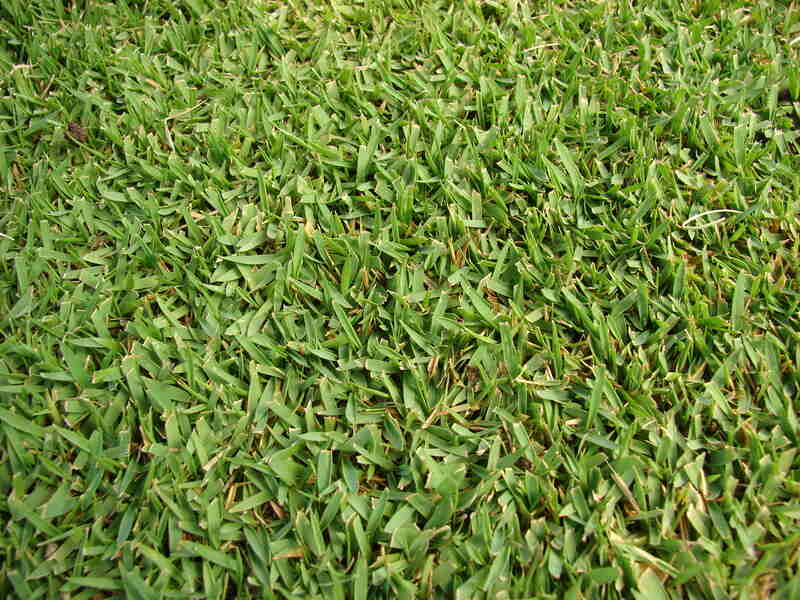
When choosing the best grass seed in Southern Indiana, it’s essential to consider the regional climate and specific needs. Temperatures around New Albany and Evansville range from the 20s in winter to the 80s in summer, so you need a grass type that does well in both cold and heat.
Tall fescue is a beautiful choice for its adaptation to the circumstances of Southern Indiana, giving a lush, low-maintenance lawn during its growing season.
Kentucky bluegrass can also thrive here, providing a thick, deep carpet of weather-resistant grass. Some homeowners in Southern Indiana even grow warm-season grasses like Zoysiagrass successfully. But note that Zoysiagrass only thrives in summer and becomes dormant in fall as temperatures cool.
Want to try out warm-season grass for a lush summer lawn? Find Zoysia seeds here:
Grass Plug and Seed Options:
– Zoysia Plugs (50 Large Grass Plugs)
– Zoysia Plugs (50 Full & Lush Grass Plugs)
– Zoysia Plugs (100 Plugs)
– Zoysia Emerald Grass Seeds (1/8 lb. of seeds)
– Zenith Zenith Grass Seeds (1/8 lb. of seeds)
How to Choose the Best Grass Seed for Your Indiana Lawn
Before you dive into selecting the best grass seed for your lawn, here are a few factors you might consider when making your choice:
- Weather: Indiana experiences a mix of mild summers and chilling winters, so you’ll want a grass variety that can withstand this fluctuating weather. Considering this, cool-season grasses such as Kentucky bluegrass, fine fescue, and perennial ryegrass thrive best in this climate.
- Foot Traffic: Think about how you intend to use the lawn. If you have a lot of foot traffic, choose tougher grass like tall fescue or Kentucky bluegrass. Fine fescue or perennial ryegrass may be appropriate for aesthetic or low-traffic areas.
- Soil: Consider your soil’s pH level and type. Most grasses thrive on well-draining soil with a pH ranging from slightly acidic to neutral. Conduct a soil test to evaluate your soil’s pH and nitrogen levels, and then select a grass type that matches these conditions. You can test your soil with an at-home kit or by sending a sample to a soil testing lab, such as A&L Great Lakes Laboratories.
- Sun and Shade Tolerance: Determine how much sunlight your Indiana lawn receives. Some grasses, such as fine fescue and perennial ryegrass, tolerate shade better than others, such as Kentucky bluegrass, which thrives in full sun. Select a grass kind that will thrive in your lawn’s sun exposure. You can also find many “sun and shade” grass seed blends that include shade-loving and sun-loving grass types.
- Drought Tolerance: Given Indiana’s occasional droughts, choose drought-tolerant grass species such as tall or fine fescue. These can tolerate dry spells with minimal water.
- Maintenance Level: Consider your willingness and abilities to maintain your lawn before planting. Some grasses must be mowed, fertilized, and watered more frequently than others. So, consider low-maintenance grasses like fine fescue or tall fescue for your lawn if you don’t have much time to invest.
FAQs About Lawn Care in Indiana
The best time for overseeding Indiana lawns with cool-season grasses is during the fall, at least 45 days before the first frost. This is when the soil is warm, and there’s sufficient moisture for seed germination.
As with overseeding, the best time to plant grass seed in Indiana for a whole new lawn is early fall when soil temperatures are between 50 and 65 degrees. However, this only goes for cool-season grasses. If you want to plant Zoysia in Southern Indiana, plant the seeds or sod in spring or summer.
While warm-season grasses like Zoysia can grow in Southern Indiana, they tend to go dormant and turn brown early in fall. Therefore, cool-season grasses are often preferred to plant in Indiana for more consistent year-round green lawns.
If you’re growing cool-season grass such as perennial ryegrass, tall fescue, fine fescue, or Kentucky bluegrass, you’ll need to mow the lawn preferably once a week in spring and fall. In the heat of Indiana’s summer, cool-season grasses tend to go dormant and stop growing, which means they won’t need mowing during this time.
Water your cool-season lawn with about 1.5 inches of water each week in spring and fall. This includes water from rainfall. Cool-season grasses may need more water in summer to survive periods of drought and intense heat.
The best time to fertilize your Indiana lawn is in fall, and if you want to apply fertilizer twice annually, the second application should be in early spring.
Finally, you may need to dethatch and aerate your lawn every year or every few years to improve the soil’s ability to absorb water and deliver it to the grass’s roots. The best time to aerate your lawn in Indiana is fall, and dethatching should be done right before aeration.
Call a LawnStarter Lawn Care Pro for Help
Indiana’s varied temperature and soil types create both opportunities and challenges for homeowners trying to establish a beautiful and healthy lawn. Therefore, choosing the best grass seed for your Indiana lawn can be tricky.
If you’re struggling to start or maintain a healthy lawn, LawnStarter’s local lawn care pros can help. Our network of local, licensed, and insured pros can provide for all your lawn care needs, from seeding to regular mowing.
LawnStarter participates in the Amazon Services LLC Associates Program, an affiliate advertising program. LawnStarter earns revenue from products promoted in this article.
Main Photo Credit: Nicholas J Klein / Canva Pro / License